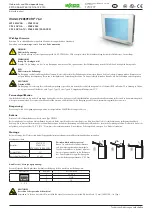
1-4(E)
5(E)
OFF
ON
OFF
ON
SW1
SW2
SW3
SW4
SW5
SW6
Configuration of Input/Output Connectors
and Signals that may be Input
The configuration of the input and output connectors
and the signals that may be input are shown below.
Input of Y/P
B
/P
R
or GBR signals
When inputting Y/P
B
/P
R
or GBR signals, you can input
Y or G signals to connectors
1
and
7
, P
B
or B
signals to connectors
3
and
9
, and P
R
or R signals to
connectors
5
and
!¡
.
You can obtain loop-through output of the above
signals from connectors
2
,
4
,
6
,
8
,
0
, and
!™
,
respectively. If you do not wish to use loop-through
output, attach 75-ohm terminators to connectors
2
,
4
,
6
,
8
,
0
, and
!™
.
Assigning Input Signals to Connectors
Before inputting signals to the BKM-48X, you must
specify the type and format of the signal that will be
input to each connector. To assign input signals to
each connector, use the on-screen INPUT
CONFIGURATION menu of your video monitor.
For information about using the INPUT CONFIGURATION
menu, refer to the manual of your video monitor.
IN
OUT
ANALOG
IN
OUT
IN
OUT
IN
OUT
IN
OUT
IN
OUT
4
5
6
1
2
3
4
5
6
7
8
9
0
!
!™
1
2
3
Using with HDM-Series Video Monitors
Functions
Analog Input and Output Signal
Connectors
The BKM-48X is equipped with input and output
connectors for two signal paths. You can input Y/P
B
/P
R
or GBR signals to the input connectors.
Floating System
Each input conector can be selected to either floating
or grounded mode by the switches on the board (SW1
to SW6, shown in the figure below).
To set the grounded mode, insert the jumper-pins into
the ON slot and the center slot. To set the floating
mode, insert the jumper-pins into the OFF slot and the
center slot.
The factory preset is grounded mode.
Floating mode is useful for rejecting common mode
noise.
Using the Input and Output
Connectors
For information about installing the BKM-48X in a video
monitor input option slot, see “Installing into Video
Monitors” (page 7 (E)).
G
B
R
Y
P
B
P
R
G
B
R
Y
P
B
P
R
1
3
5
7
9
!¡
2
4
6
8
0
!™
Grounded mode
Floating mode
6(E)
Aperture compensation (Y/R–Y/B–Y)
Off: 0 dB
On: 2 to 6 dB (5 MHz)
Return loss
43 dB min. (10 MHz, 75-ohm
terminated)
Signal Characteristics (Using with HDM-
Series Video Monitors)
Analog component (Y/P
B
/P
R
, GBR) signals
Signal level
Y/P
B
/P
R
Y: 1 Vp-p ±6 dB
P
B
: 0.7 Vp-p ±6 dB
P
R
: 0.7 Vp-p ±6 dB
G/B/R
1 Vp-p ±6 dB (sync on G)
Frequency characteristics
Y
50 Hz to 30 MHz ±1dB
P
B
/P
R
50 Hz to 30 MHz ±1dB
G/B/R
50 Hz to 30 MHz ±1dB
Chrominance signal/luminance signal
Delay time error
30 nsec max.
Gain error
5% max.
Return loss
43 dB min. (10 MHz, 75-ohm
terminated)
Accessory Supplied
Installation Manual (1)
Design and specifications are subject to change
without notice.
General
Power requir5 V, ±6 V, ±15 V (supplied
from the monitor)
Power consumption 6W
Recommended operating temperature
20°C to 30°C (68°F to 86°F)
Permissible operating temperature
0°C to 35°C (32°F to 95°F)
Operating humidity 0% to 90% (no condensation)
Maximum external dimensions (w/h/d)
25
×
256
×
245 mm
(
31
/
32
×
10
1
/
8
×
9
3
/
4
inches)
Mass
660g (1lb 7 oz)
Input/Output Connectors
BNC
×
6, high impedance, with loop-through output
Signal Characteristics (Using with BVM-
Series Video Monitors)
Analog composite signals
Signal level
1 Vp-p +3 dB/–6 dB
Return loss
43 dB min. (10 MHz, 75-ohm
terminated)
YC signals
Signal level
Y: 1 Vp-p ±6 dB
C: 0.286 Vp-p ±6 dB (NTSC
burst signal level)
0.3 Vp-p ±6 dB (PAL burst
signal level)
Analog component (Y/R–Y/B–Y, RGB) signals
Signal level
Y/R–Y/B–Y Y: 1 Vp-p ±6 dB
R–Y: 0.7 Vp-p ±6 dB
B–Y: 0.7 Vp-p ±6 dB
R/G/B
1 Vp-p ±6 dB (sync on G)
Frequency characteristics
Y
50 Hz to 10 MHz ±1dB
R–Y/B–Y
50 Hz to 6 MHz ±1dB
R/G/B
50 Hz to 30 MHz ±1dB
Chrominance signal/luminance signal
Delay time error
30 nsec max.
Gain error
5% max.
Specifications











































